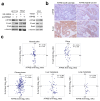ATP Synthase Subunit Epsilon Overexpression Promotes Metastasis by Modulating AMPK Signaling to Induce Epithelial-to-Mesenchymal Transition and Is a Poor Prognostic Marker in Colorectal Cancer Patients
- PMID: 31330880
- PMCID: PMC6678251
- DOI: 10.3390/jcm8071070
ATP Synthase Subunit Epsilon Overexpression Promotes Metastasis by Modulating AMPK Signaling to Induce Epithelial-to-Mesenchymal Transition and Is a Poor Prognostic Marker in Colorectal Cancer Patients
Abstract
Metastasis remains the major cause of death from colon cancer. We intend to identify differentially expressed genes that are associated with the metastatic process and prognosis in colon cancer. ATP synthase epsilon subunit (ATP5E) gene was found to encode the mitochondrial F0F1 ATP synthase subunit epsilon that was overexpressed in tumor cells compared to their normal counterparts, while other genes encoding the ATP synthase subunit were repressed in public microarray datasets. CRC cells in which ATP5E was silenced showed markedly reduced invasive and migratory abilities. ATP5E inhibition significantly reduced the incidence of distant metastasis in a mouse xenograft model. Mechanistically, increased ATP5E expression resulted in a prominent reduction in E-cadherin and an increase in Snail expression. Our data also showed that an elevated ATP5E level in metastatic colon cancer samples was significantly associated with the AMPK-AKT-hypoxia-inducible factor-1α (HIF1α) signaling axis; silencing ATP5E led to the degradation of HIF1α under hypoxia through AMPK-AKT signaling. Our findings suggest that elevated ATP5E expression could serve as a marker of distant metastasis and a poor prognosis in colon cancer, and ATP5E functions via modulating AMPK-AKT-HIF1α signaling.
Keywords: AMPK; ATP5E; Colorectal Cancer; EMT; Metastasis.
Conflict of interest statement
The authors declare no conflict of interest.
Figures




References
-
- Sargent D.J., Patiyil S., Yothers G., Haller D.G., Gray R., Benedetti J., Buyse M., Labianca R., Seitz J.F., O’Callaghan C.J., et al. End Points for Colon Cancer Adjuvant Trials: Observations and Recommendations Based on Individual Patient Data from 20,898 Patients Enrolled Onto 18 Randomized Trials from the ACCENT Group. J. Clin. Oncol. 2007;25:4569–4574. doi: 10.1200/JCO.2006.10.4323. - DOI - PubMed
-
- Bates R.C., Mercurio A.M. The epithelial-mesenchymal transition (EMT) and colorectal cancer progression. Cancer Biol. Ther. 2005;4:365–370. - PubMed
Grants and funding
LinkOut - more resources
Full Text Sources
Research Materials

